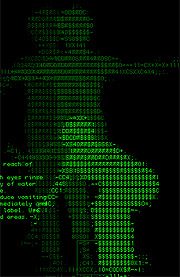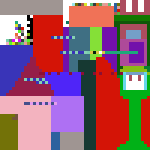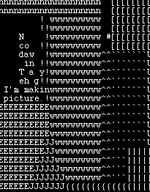September 30, 1999

By MATTHEW MIRAPAUL 
Exploring the Aesthetics of Plain Old Text
 context, the newest work of online art by Andy C. Deck, has a lot of character -- 128 of them, to be exact.
context, the newest work of online art by Andy C. Deck, has a lot of character -- 128 of them, to be exact.
|

|
In "Windowsninetyeight," a CD-ROM work by Bruno Martelli, dancing figures are outlined in Ascii characters.
|
Built around the 128-character computer code known as Ascii, the basis for most computer text, the Web-based Icontext is an ingenious combination of word processor, paint program and chat software. Visitors to the site, which is being launched Thursday, can write in pictures or draw with words in a real-time chat space that allows both verbal communication and collaborative art-making.
Deck's use of Ascii (pronounced ASK-ee) to explore the intersection of text and image is a logical choice. For years, e-mail messages and other forms of computer communication have contained Ascii art, pictures made from precisely arranged letters, numbers and punctuation marks.
But Icontext is also the latest example of how digitally adept artists, including Vuk Cosic in Slovenia and Bruno Martelli in London, are rediscovering the simple virtues of Ascii and expanding its aesthetic possibilities beyond projects like a rudimentary remake of the first 'Star Wars' movie.
In a telephone interview from his New York studio, Deck outlined some of the reasons that digital artists might be turning to Ascii.
"One aspect of Ascii art that is compelling to a lot of people right now is its difference from the ray-tracing images that are often described in some circles as computer art," he said. Using Ascii "is a flag indicating an attitude that image-making with computers is not merely the technical pursuit of creating the perfect simulation."
At the same time, Deck said, there is a forward-thinking element in working with Ascii. "To use it as an artist," he said, "is a rejection of the idea that art with computers needs to be some sort of simulation of the painting process. So many of the paint-oriented programs have little buckets and brushes, and the use of Ascii may signal a move away from those metaphors."
For Cosic, Ascii provides an opportunity to comment on the artistic media of the past, and his Web site is home to a series of pioneering Ascii-based projects that he has produced since October 1998.
The first effort was an animated-Ascii rendering of the pornographic film "Deep Throat," which was initially shown on a Pong arcade-game screen in a gallery. This was followed by animated-Ascii versions of films like "King Kong" and an online gallery of "Ascii Art for the Blind," in which Ascii renderings of the Venus de Milo and other fine-art totems are read aloud by a synthesized voice ("dollar sign, dollar sign, comma..."). More recently, Cosic has collaborated on Ascii music videos and developed an Ascii camera that prints its images on supermarket receipts.
"It was important for me to try out Ascii in all of its possible but never-achieved developments," Cosic said. "I'm taking it to the same heights where all other media have arrived so far."
Cosic's deconstruction of the classics prompts viewers to recognize that new-media art must forsake old-media models, but he also wants digital artists to reconsider the assumption that high-tech art must rely on the latest high-tech tools.


|
An icon from Andy Deck's "Icontext" entitled "kleeScape," and a detail from its Ascii counterpart.
|
|
Ascii, which stands for "American Standard Code for Information Exchange," was created in 1963 as a standardized way of storing textual information in digital form. The term is now used to refer to plain text without any fancy formatting or graphics. Long before there was a Web or HTML, people created Ascii art as a way to include images in their e-mail.
Cosic calls such illustrations "naive Ascii art" and will include a sampling of them in a cultural history of the medium that will be published next year on CD-ROM. Cosic said the Center for Art and Media Technology (Zentrum for Kunst und Medientechnologie, or ZKM) in Karlsruhe, Germany, has agreed to issue the disk.
Ted Byfield, a freelance editor and writer in New York who will contribute to the history project, said Ascii's minimalist feel appeals to artists. "There's something really primitive and simple about it, and it tends to reduce artistic problems to a very interesting level," he said. "It's almost like giving an artist a box of Tinker Toys and saying, 'Go.'"
Byfield also believes that "Ascii art provides an interesting inroad for learning about the history of the aesthetic dimension of computing, the ways in which people played with available resources without getting involved in the heavily graphical user interfaces."
Bruno Martelli, an artist and designer in London, said there is a divide between technology haves and have-nots in the arts world.
"In movies like 'Star Wars' or 'Jurassic Park' or 'Godzilla,'" Martelli said, "you know that with computer graphics you can make anything seem real -- a space ship, a dinosaur, whatever. But the amount of money you need to spend on getting to that level of reality is so prohibitively expensive. Artists know they can never have the budget to get up to that level of sophistication, so they say, 'O.K., we have to go the other way now; we have to go cheap and cheerful.' Then it's not about how big and shiny your computer is, it's about how good your ideas are."
Martelli's ideas can be seen on Windowsninetyeight, an interactive work that is being released on CD-ROM this week. Produced in collaboration with the choreographer Ruth Gibson, the piece captures a day in the life of three women living in a high-rise apartment building. In two dazzling scenes, a dancing woman's outlined figure is filled with Ascii characters, and one of the scenes allows users to input text that will glow within the undulating shape.
Martelli said he was drawn to the visual effects generated by the animated Ascii. "You get this really nice animation 'boil,'" he explained, "because one area -- one pixel, if you like -- is sometimes represented as a colon and sometimes as a semi-colon and sometimes as a dot. That's just one pixel, and it happens over the whole figure, so when it runs, even when the figure is standing still, you get a nice shimmer."
Deck was inspired to create Icontext after he opened some text files on his computer and responded to how they looked, not what they said. He also has a long-standing interest in the interplay between words and pictures, as well as a fascination with the possibilities of online collaboration.
Icontext functions somewhat like an automated illuminated manuscript. Typing characters anywhere in a large 50 by 50 grid of squares instantly generates colored boxes in a corresponding location on a smaller grid, so that the writing yields images. But users can also draw in the smaller grid and watch as their actions spawn writing. The work can also be used as a visually dynamic chat room, where visitors can write (or overwrite others' remarks) anywhere on the screen.
Icontext also functions as a database for contributors' texts and images. Existing entries can be modified by new visitors, and collaborative efforts are encouraged.
"I've tried to figure out ways to use interaction between people in such a way that it won't fall flat if they just doodle, which is what people tend to do," Deck said. "I would like to demonstrate that there is a potential for doing interesting things together online, collaboratively."
arts@large is published on Thursdays. Click here for a list of links to other columns in the series.
Related Sites
These sites are not part of The New York Times on the Web, and The Times has no control over their content or availability.
Matthew Mirapaul at mirapaul@nytimes.com welcomes your comments and suggestions.